To tilt up and down, the 140-foot (43-meter) telescope in Green Bank, West Virginia rides on an enormous toothy gear. The 42-foot diameter gear is bolted to the back of the dish’s superstructure. Two brass pinions engage this bull gear. The brake, which you can see to far right, is one of several designed and built by Goodyear Tire and Rubber Company.
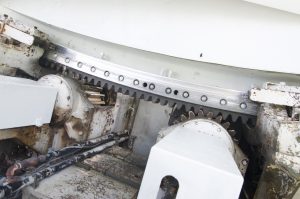
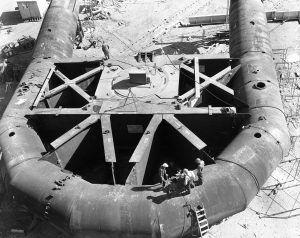
Fitting the Yoke
Assembled yoke of the 140-foot (43-meter) telescope on the ground in Green Bank, West Virginia during its construction in the 1960s. The yoke supports the telescope’s tilt axis and keeps the giant telescope balanced as it arcs across the sky. Pacific Crane and Rigging Company completing the final assembly of the yoke components (made by Sun Shipbuilding) to the hub section (built and machined by Westinghouse). The hub section consists of a 3.5% nickel steel casting welded to 6 inch, A 201 plate for a finished machined weight of 190 tons. When completed the entire yoke is a single weldment. Its completed weight is 1,125,000 pounds of steel to which are added 1,300,000 pounds of counterweight concrete and portable ballast rocks in the tubular, bottom sections.
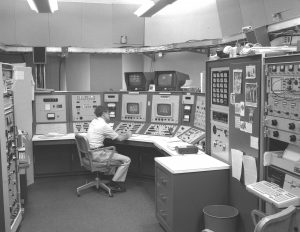
140-foot Control Room Upgrade
In 1972, the control room of the 140-foot telescope in Green Bank, West Virginia got an upgrade. Analog systems were replaced by computer systems, and by the time of this photo in 1985, operation of the telescope required only one staff member instead of four.
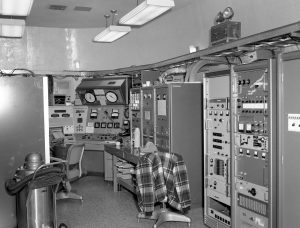
Mission Control for the 140-foot
The original control room for the 140-foot telescope sits at the base of the telescope, inside a concrete building with walls that are 3-feet thick. The guidance and data systems lined the wall of this room on the ground floor. Three to four people would be in this room during early observations with the 140-foot telescope in the 1960s and 1970s, including operators, engineers, and astronomers. Now, the updated and renamed 43-meter telescope can be run by a laptop in a drawer!
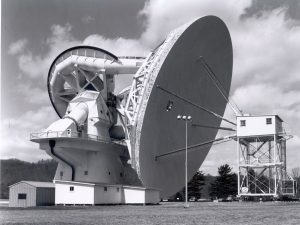
Coming Down to Earth
When the 200-foot tall dish telescope in Green Bank, West Virginia needed receiver maintenance, operators drove its 140-foot (43-meter) dish to within four feet of the ground. An engineering tower was winched up until the apex of the telescope was nestled inside. Then, in a protected space, the sensitive equipment was removed, replaced, and finely adjusted. These days, the 140-foot has not been using a receiver at its apex. Instead, a sophisticated second reflector sits here to bounce waves to receivers nestled in the hole in the center of the dish. The tower is still used to work on the apex.

Waiting for Liftoff
The 266-ton dish superstructure (BUS) for the 140-foot (43-meter) telescope in Green Bank, West Virginia has been completely assembled and awaits hauling onto the telescope’s yoke in November, 1964. The maneuver took longer than expected: the superstructure was dropped accidentally during a derrick failure.





